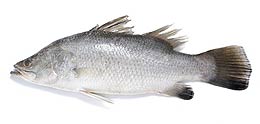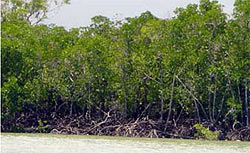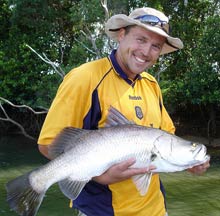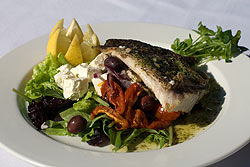About Barramundi
The Barramundi (Lates calcarifer) is also known as Asian Seabass. Barramundi is an Aboriginal word meaning "large-scaled river fish". It is also known as the Asian seabass by scientists around the world, but is also known as giant perch and giant seaperch. It belongs to the perch family of fishes
They live live on or near the bottom of coastal waters, estuaries, lagoons and freshwater rivers in clear to muddy water; usually within a temperature range of 26-30oC. They can grow to 1.8 metres in length although this is quite rare. 1.2 m length is common. They can weigh over 40 kg. Adult barramundi are carnivores, feeding on insects, crustaceans, molluscs, and smaller fish(including its own species); juveniles feed on zooplankton. |

|
They are highly prized by anglers for their good fighting ability. Rivers in the Northern Territory such as East Aligator, South Aligator, Daly River, Shady Camp, Roper River and Victoria River have great reputations amongst Australian and international fishers, attracting large numbers of visitors each year.
Barramundi have white, flaky flesh, though the larger freshwater ones commonly carry a lot of body fat. Saltwater barramundi, are considered to be very good eating.
In the Northern Territory, commercial barramundi fishing uses nets up to 1,000 metres long. There are 21 Barramundi licences issued. Most commercial fishing takes place from the high water mark at the coast to 3 nautical miles seaward of the low water mark. The fishery is managed on behalf of the Northern Territory by the NT Fisheries Group under a formal management plan. The professional fishing season runs from 1 February to 30 September.
Barramundi have become a very popular fish so the demand for them is much greater than can be met by catching them from the wild. In fact, almost 75% of the barramundi eaten in Australia is imported from Asia and sometimes fish other than barramundi are sold as barramundi.
Reproduction and Life Cycle
Barramundi normally breed in river mouths and bays near areas of suitable nursery habitat. Their breeding season faround Darwin area coincides with the return to large spring tides and increasing water temperatures in mid to late August and lasts until March, however fish kept under artificial conditions can be spawned all year round. Areas such as mangrove
swamps and low-lying land that becomes flooded during spring tides and monsoonal rains
provide ideal habitats for young barramundi.
The female produces many millions small, non-adhesive, pelagic, pink eggs between 0.6 mm and 0.9 mm in diameter .. The eggs hatch within 15 to 20 hours at which time the larvae are around 1.5 mm in length and the mouth and eyes are well developed, although the yolk sac is large. At 2.5 mm the mouth is large and open, the yolk sac is greatly reduced and the pectoral fins are beginning to develop. Above this size the larvae begin to exhibit the characteristic colouration of juveniles of this species - overall brown mottled markings with a white stripes running lengthwise along the head. At 3.5 mm the yolk sac is all but gone, fin rays are beginning to appear and the teeth are well developed. By the fifth day the yolk sac has been completely absorbed and by 8.5 mm the fins are fully developed.

|

Most barramundi begin their lives as males and becoming female after at least one spawning season at three to four years of age ; most of the larger specimens are therefore female. |
The flavour is mild, subtle and highly prized. Barramundi are very versatile when it comes to cooking: they can be fried, grilled, char-grilled, barbecued, steamed, wrapped in banana leaves or paper bark and cooked on hot coals, or just dropped straight on a fire.

|
|